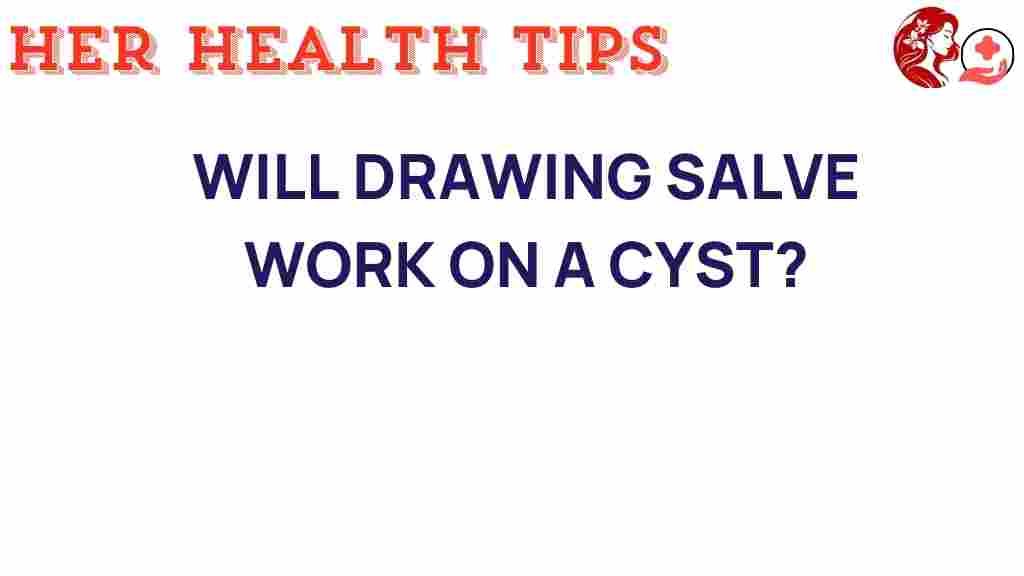The Truth Behind Drawing Salves: Can They Really Cure Cysts?
In the realm of natural remedies and alternative medicine, drawing salves have garnered attention as a potential solution for various skin issues, including cysts. Many people seek cyst treatment options that are less invasive than traditional medical procedures, leading to a surge in interest surrounding these topical ointments. But what is the truth behind drawing salves? Can they really cure cysts, or are they just another health myth? In this article, we will explore the effectiveness of drawing salves, their ingredients, and how they fit into a holistic approach to wellness and skin care.
Understanding Drawing Salves
Drawing salves are topical ointments traditionally used to draw out impurities from the skin. They are often made from a combination of natural ingredients, including:
- Activated charcoal
- Herbal extracts
- Beeswax
- Essential oils
These ingredients are believed to work together to pull toxins and other unwanted substances from the skin, which is why many people consider them for treating cysts and other skin conditions.
What Are Cysts?
Cysts are closed pockets of tissue that can be filled with fluid, pus, or other material. They can occur anywhere on the body and vary in size. While most cysts are harmless, they can sometimes cause discomfort or be a cosmetic concern. Typical types of cysts include:
- Epidermoid cysts
- Pilar cysts
- Baker’s cysts
- Dermoid cysts
When it comes to cyst treatment, many individuals prefer to explore holistic healing options before considering surgical removal or medical intervention.
Do Drawing Salves Work on Cysts?
The effectiveness of drawing salves on cysts is a topic of debate within the fields of dermatology and alternative medicine. While some anecdotal evidence suggests that these salves can help reduce the size of cysts or promote drainage, scientific research is limited. Here are some key points to consider:
- Limited Evidence: There are few clinical studies that support the use of drawing salves for cyst treatment. Most claims are based on personal experiences rather than scientific data.
- Potential Benefits: Some ingredients in drawing salves—like activated charcoal—are known for their ability to absorb impurities, which could theoretically assist in the treatment of cysts.
- Not a Replacement: Drawing salves should not replace professional medical treatment for cysts, especially if they are painful, infected, or growing.
How to Use Drawing Salve for Cysts
If you decide to try a drawing salve as part of your skin care regimen for cysts, here’s a step-by-step process to follow:
- Choose the Right Salve: Look for a drawing salve that contains natural ingredients known for their healing properties. Always check for any allergens.
- Clean the Area: Gently clean the cyst area with mild soap and water, and pat dry with a clean towel.
- Apply the Salve: Use a clean finger or applicator to apply a generous amount of the drawing salve directly onto the cyst.
- Cover the Area: If necessary, cover the area with a clean bandage to keep the salve in place and to protect it from dirt and bacteria.
- Leave It On: Allow the salve to sit on the cyst for several hours or overnight, depending on the product’s instructions.
- Wash Off: After the recommended time, gently wash off the salve and assess the area. Repeat as needed.
Common Misconceptions About Drawing Salves
Drawing salves are often surrounded by misconceptions that can lead to unrealistic expectations. Here are some common myths:
- Myth 1: Drawing salves can completely cure cysts without any medical intervention.
- Myth 2: All drawing salves are the same and equally effective.
- Myth 3: If a drawing salve doesn’t work, it means the cyst is serious.
It’s essential to approach these products with a balanced perspective and to recognize that while they may provide some relief, they are not a cure-all.
Troubleshooting Tips for Using Drawing Salves
When using drawing salves, you might encounter some challenges. Here are troubleshooting tips to help you:
- Skin Irritation: If you experience irritation or an allergic reaction, discontinue use immediately and consult a healthcare professional.
- Limited Results: If the cyst does not improve after repeated use, it may be time to seek advice from a dermatologist.
- Infection Signs: If the cyst appears red, swollen, or painful, it may be infected and require medical treatment.
Alternative Natural Remedies for Cysts
If you’re looking for other natural remedies to complement the use of drawing salves, consider the following:
- Warm Compress: Applying a warm compress can help reduce inflammation and promote drainage.
- Tea Tree Oil: Known for its antibacterial properties, tea tree oil can be applied to the cyst to help prevent infection.
- Apple Cider Vinegar: Some people find success using diluted apple cider vinegar topically for its potential anti-inflammatory effects.
Always consult with a healthcare provider before starting any new treatment regimen, especially if you have underlying health conditions or are taking medications.
Conclusion
Drawing salves may hold some potential as a cyst treatment option for those seeking holistic healing and natural remedies. However, it’s crucial to approach them with realistic expectations and an understanding of their limitations. While these salves can provide symptomatic relief for some, they are not a substitute for professional medical advice and treatment.
As with any aspect of skin care and health, staying informed is key. If you’re uncertain about treating a cyst or any skin condition, consult with a qualified dermatologist. Remember, your health and well-being should always come first.
For further reading on skin care and wellness, check out this informative article. And for more insights into health myths and natural treatments, visit Healthline.
This article is in the category Conditions and created by HerHealthTips Team
